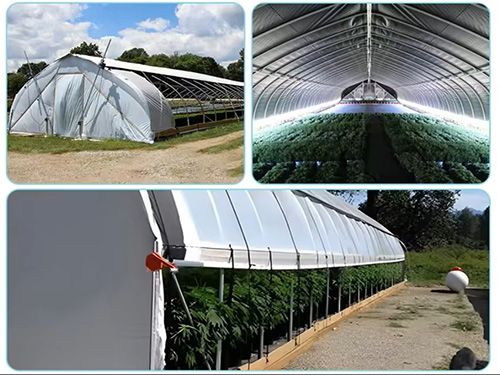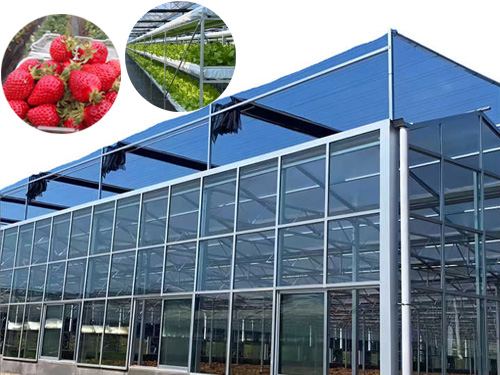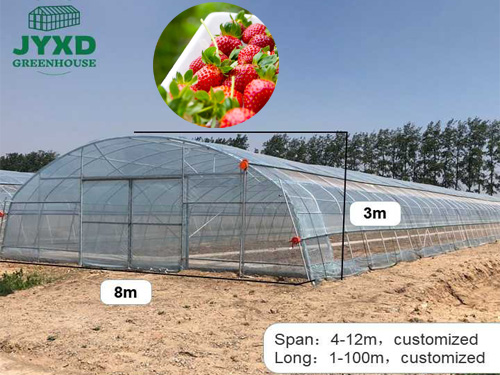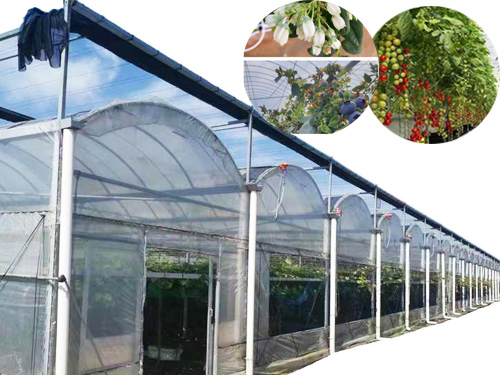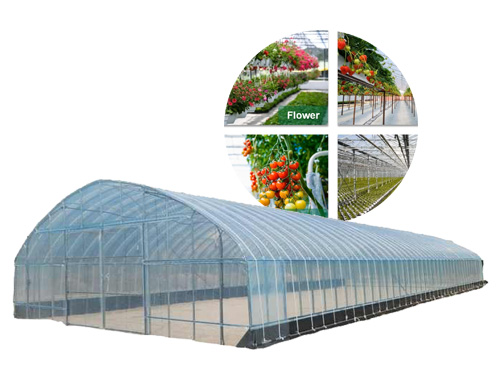NEWS DETAILS
NEWS INFORMATION
Greenhouse Ecosystem Management: Achieving Sustainable Agriculture
AUTHOR:jyxd-greenhouse DATE:2025-03-27 12:21:38 HITS:70
As the demand for sustainable agricultural practices continues to rise, greenhouse ecosystem management has become a critical focus in modern farming. Greenhouses, with their controlled environments, offer unique opportunities to optimize plant growth, reduce resource consumption, and minimize the impact on the environment. Effective ecosystem management in greenhouses can ensure a balanced environment that supports healthy plant growth while promoting sustainable agricultural practices. This article will explore the concept of greenhouse ecosystem management, its key components, and how it contributes to achieving sustainable agriculture.
What is Greenhouse Ecosystem Management?
Greenhouse ecosystem management refers to the strategic management of the various elements within a greenhouse to create a balanced and productive environment. This includes controlling factors such as temperature, humidity, light, air circulation, and soil or hydroponic systems. The goal is to maintain conditions that promote healthy plant growth while minimizing waste, conserving resources, and reducing environmental impact.
Effective ecosystem management goes beyond merely controlling environmental factors; it also involves the integration of biological, chemical, and technological solutions to ensure sustainability. By adopting an ecosystem-based approach, greenhouse managers can optimize plant health, increase yields, reduce the need for chemical inputs, and create a more efficient and environmentally friendly growing system.
Key Components of Greenhouse Ecosystem Management
1. Climate Control
Climate control is a fundamental aspect of greenhouse ecosystem management. Greenhouses offer the advantage of controlling temperature, humidity, and light levels to create optimal conditions for plant growth. Climate control systems use a combination of heating, cooling, ventilation, and shading to maintain the ideal temperature and humidity levels inside the greenhouse.
Automated climate control systems can adjust these factors in real-time, ensuring that plants receive consistent care regardless of outdoor weather conditions. For example, during hot weather, ventilation systems may be increased to cool the greenhouse, while heating systems will maintain warmth during colder months. By optimizing climate control, greenhouse operators can increase crop yields, reduce energy consumption, and minimize the environmental impact of farming operations.
2. Water and Nutrient Management
Efficient water and nutrient management are essential components of sustainable greenhouse ecosystem management. Since water is a limited resource, it is important to implement strategies that conserve and recycle water within the greenhouse. Hydroponics, aquaponics, and drip irrigation systems are commonly used to optimize water use and reduce waste. These systems allow nutrients and water to be delivered directly to plant roots, ensuring that crops receive exactly what they need without excess runoff.
Nutrient management is also crucial for sustainable agriculture. By using precision fertilization techniques, greenhouse operators can reduce the need for synthetic fertilizers, which can be harmful to the environment if used excessively. Organic fertilizers, composting, and bio-based nutrient solutions can be incorporated into the greenhouse ecosystem to promote soil health and reduce the environmental impact of farming.
3. Integrated Pest Management (IPM)
One of the most important aspects of sustainable greenhouse ecosystem management is pest control. Traditional pest control methods, such as synthetic pesticides, can harm the environment, beneficial insects, and pollinators. Integrated Pest Management (IPM) provides a more sustainable approach by combining biological, cultural, and mechanical controls to manage pests without relying on chemical pesticides.
Biological pest control involves introducing natural predators, such as ladybugs or parasitic wasps, into the greenhouse to control pest populations. Cultural practices, such as crop rotation, using resistant plant varieties, and proper sanitation, can help prevent pest infestations. Mechanical controls, like sticky traps or insect barriers, can further reduce pest pressure. By using IPM, greenhouse managers can protect crops while minimizing the impact on the ecosystem.
4. Soil Health and Sustainability
For greenhouses that use soil-based growing systems, maintaining soil health is a key component of ecosystem management. Healthy soil provides essential nutrients and support for plants, and managing soil health is crucial for long-term sustainability. Sustainable soil management practices include crop rotation, cover cropping, and the use of organic matter to improve soil structure and fertility.
In hydroponic or aquaponic systems, soil is replaced with a growing medium or water-based nutrient solutions. However, the principles of sustainability still apply. These systems rely on maintaining a balanced ecosystem of nutrients, water, and microorganisms to support plant growth. By regularly monitoring and adjusting nutrient levels, greenhouse managers can ensure optimal plant health while reducing waste and environmental impact.
5. Energy Efficiency and Resource Conservation
Energy efficiency is another critical factor in greenhouse ecosystem management. Traditional greenhouses often require significant amounts of energy for heating, cooling, and lighting. However, modern greenhouse technologies are increasingly focused on reducing energy consumption and improving overall efficiency. For example, the use of energy-efficient LED lighting, solar panels, and geothermal heating systems can significantly reduce the energy needed for greenhouse operations.
Resource conservation also extends to materials used in the greenhouse construction and maintenance. Eco-friendly materials, such as recycled plastic or sustainable building materials, can help reduce the environmental footprint of the greenhouse. Additionally, optimizing water usage, reducing waste, and recycling plant materials further contribute to the sustainability of the greenhouse ecosystem.
Benefits of Greenhouse Ecosystem Management
1. Increased Crop Yields
By managing environmental factors such as temperature, humidity, and light levels, greenhouse managers can create ideal growing conditions that maximize crop yields. Greenhouses also protect plants from external factors such as pests, extreme weather, and soil-borne diseases, leading to healthier plants and higher productivity.
2. Resource Efficiency
Efficient use of resources, such as water, energy, and nutrients, is essential for sustainable agriculture. Greenhouse ecosystem management enables farmers to minimize waste and reduce the amount of resources required to grow crops. This not only reduces costs but also helps protect the environment by conserving vital resources.
3. Reduced Environmental Impact
By adopting sustainable practices such as IPM, organic farming, and water recycling, greenhouse operators can reduce their environmental footprint. Greenhouses have the potential to produce food with minimal reliance on chemical pesticides, fertilizers, and herbicides, resulting in cleaner, healthier food for consumers. Additionally, greenhouse farming can help reduce the carbon footprint of agriculture by minimizing transportation needs and enabling local food production.
4. Resilience to Climate Change
Greenhouses offer a level of resilience to climate change, as they allow farmers to control growing conditions regardless of external weather patterns. This is especially important in areas with unpredictable or extreme weather events. By ensuring stable and controlled growing environments, greenhouse operators can produce crops consistently and reliably, even in the face of climate-related challenges.
Conclusion
Greenhouse ecosystem management plays a crucial role in achieving sustainable agriculture. By focusing on climate control, water and nutrient management, integrated pest management, soil health, and resource conservation, greenhouse operators can create a productive, efficient, and environmentally friendly farming system. As the global population continues to grow and the demand for sustainable food production increases, greenhouse ecosystem management will be an essential strategy for meeting future agricultural needs while protecting the planet. By adopting these practices, farmers can help ensure a sustainable food supply for generations to come.
Hebei Juyou Xinda Greenhouse Facilities Co.,Ltd.
Copyright © 2024-2025 https://www.jyxd-greenhouse.com. All Rights Reserved Hebei Juyou Xinda Greenhouse Facilities Co.,Ltd.Copyright





 Current Location:
Current Location:


